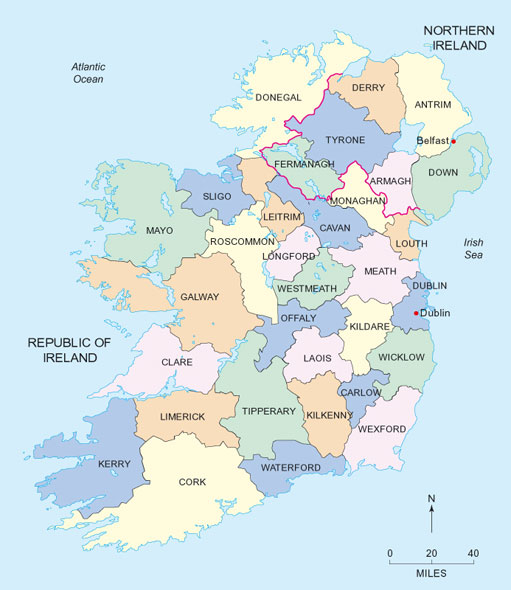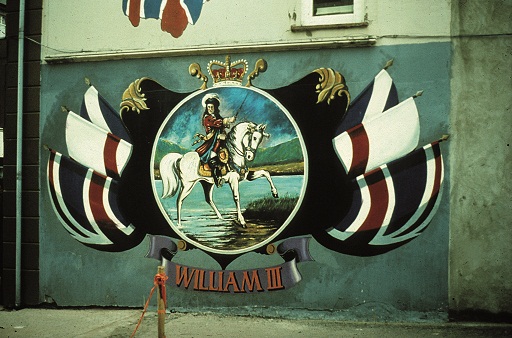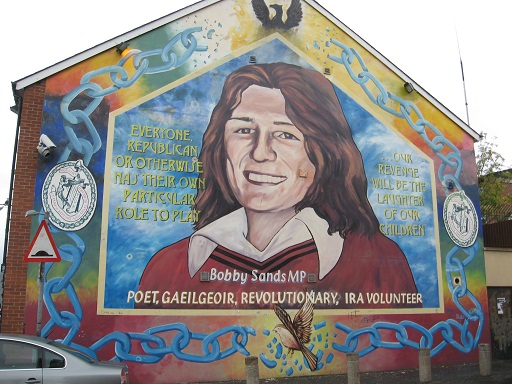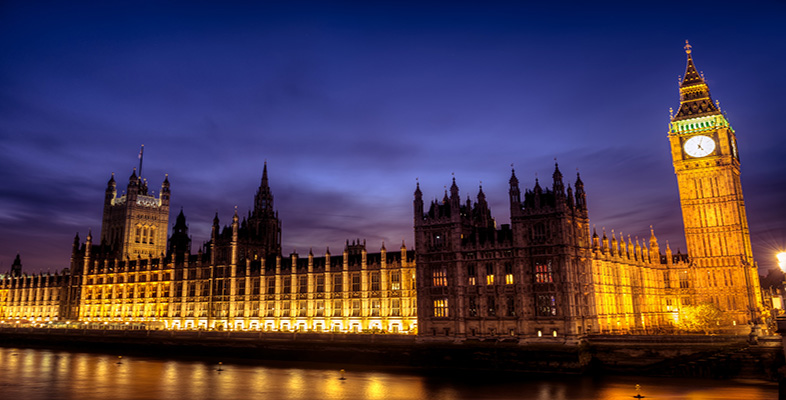5.1 State renewal and repair in Northern Ireland
The creation of Northern Ireland in 1921 demonstrates that the link between a state, its territory and the people within these territorial boundaries is not pre-given. Following the War of Independence with Britain from 1919 to 1921, the partition of Ireland in 1921, as a result of the Government of Ireland Act in 1920, led to the creation of an independent Irish Republic in the south and a British-controlled Northern Ireland (see Figure 6). Northern Ireland’s territorial boundaries were drawn by the British Government in order to incorporate as much as possible of the large Protestant population of Ulster who had opposed Home Rule in the wake of partition in favour of union with Britain.
At the heart of the politics of Northern Ireland is a divided population that experiences the state in quite different ways. In simplified terms, a majority in Northern Ireland, although they represent only a minority in Ireland as a whole, regard themselves as British and want Northern Ireland to remain a part of the United Kingdom. This majority of Unionists, and their radical form, the Loyalists, are also predominantly Protestant. A sizeable minority within Northern Ireland, 44 per cent according to the 2001 Census, define themselves as Irish and Catholic, although an increasing number of people do not see themselves as belonging to either category. The Catholic Nationalists, and their radical form, the Republicans, would prefer to be ruled by a single, Irish authority. For the Catholic minority within Northern Ireland, the creation of Northern Ireland in 1921 established ‘an artificial state, devoid of geographical, historical or political logic’ (Tonge, 2001, p. 634). Both the Protestant majority and the Catholic minority, however, are not static. The size of the majority and minority fluctuates over time. Moreover, both within and outside this majority and minority, other majorities and minorities based on gender, age, sexual orientation, disability, ‘race’ and ethnicity, for example, coexist.
The tradition of mural painting in Northern Ireland provides an insight into the political dynamics of these changing communities. When and where murals appear, what they express and what they don’t express, how they are renewed and repaired or how they are forgotten and left to fade provide insights into the political process and the ways in which power is expressed and contested in Northern Ireland. As you read this section, think about the ideas of zero-sum and positive-sum power and try to decide how they apply to the changing community relationships in Northern Ireland.

For cultural historian and museum exhibition designer Judy Vannais (2001), there are two separate traditions of mural painting in Northern Ireland which are indicative of two different relationships to the state. On the one hand, the Unionist/Loyalist tradition of mural painting has been going on for more than a century. This long tradition denoted a community at ease and confident in its relationship with the state. Mural painting was an expression of this confidence and it literally represented a claiming of public space and territory, and an assertion of identity and belonging, that was evidence of the Protestant domination of politics and society in Northern Ireland. Prior to the 1970s, the majority of Unionist/Loyalist murals were linked to the annual commemoration of the Battle of the Boyne on 12 July 1690, when Protestant Prince William of Orange defeated Catholic King James II in the struggle for the English throne. The dominant image in these murals was of ‘King Billy’ astride his white horse crossing the River Boyne (see Figure 7).

The Nationalist/Republican tradition of mural paintings, on the other hand, dates only from the beginning of the 1980s, though attempts to claim territory through painting slogans, for example, pre-dated mural paintings. The late development of mural painting as an expression of the Nationalist/Republican community, in comparison with the early development of Unionist/Loyalist painting, is indicative of a very different relationship to the state. Nationalists and Republicans in Northern Ireland generally rejected the idea of Northern Ireland as a separate state and did not feel that the state belonged to them. The state’s laws and daily practices were a constant reminder that the Nationalist/Republican community was a minority in a state that belonged to the majority Unionist/Loyalist community. Nowhere was this exclusion felt more strongly than in the policing of Northern Ireland. Jon Tonge notes that the Special Powers Act of 1922 gave the predominantly Protestant security forces in Northern Ireland vast and arbitrary powers. The Royal Ulster Constabulary averaged only 10 per cent Catholic membership while the auxiliary police force, the B Specials, was exclusively Protestant (Tonge, 2001, p. 634). For Catholics, there was nothing legitimate about the state’s claim to a monopoly of force in Northern Ireland.
The late development of Nationalist/Republican mural painting, therefore, denoted a community which felt excluded from the state and feared showing its identity in public. Events in the 1970s, however, forced a change in the politics of Northern Ireland and in community relations, and these changes were reflected in changes in the two communities’ mural painting traditions. Influenced by similar movements in the USA, in the 1960s the Nationalist/Republican communities began a series of civil rights marches demanding an end to discrimination against Catholics in the political, economic and social spheres. Specifically, Catholics demanded police reform and a fairer voting system to end Unionist domination of the political system in Northern Ireland, where Unionist Party control of the parliament at Stormont from 1922 to 1972 was matched by Unionist control of 85 per cent of local councils (Tonge, 2001, p. 634). Political discrimination was reinforced by discrimination in education, housing provision and employment.
The increasingly harsh response by the police, and ultimately the British military forces, to the civil rights movement led to a spiral of violence that marked the beginning of the ‘Troubles’. The last big civil rights march, on 30 January 1972, became known as Bloody Sunday following the killing of fourteen civilians by British soldiers. Later in 1972, the Northern Ireland parliament was dissolved and direct rule was imposed from Westminster. The state’s claim to its monopoly of legitimate force was challenged directly, on the one hand by the Provisional Irish Republican Army (IRA), a left-wing paramilitary organisation that sought to bring about a united Ireland, and on the other hand by various Loyalist paramilitary groupings, such as the Ulster Volunteer Force, the Ulster Defence Association and the Ulster Protestant Volunteers, which fought to maintain Northern Ireland’s status within the UK.
Although the onset of the ‘Troubles’ curtailed the civil rights movement’s reclaiming of public space through protest marches, the Nationalist/Republican community began to assert its control of public space visually through an explosion of mural painting. The main catalyst for change was the hunger strike of 1981 by Republican prisoners demanding the reinstatement of their prisoner-of-war status which had been revoked by the British authorities in 1976. From this moment onwards, the Nationalist/Republican community began to use mural painting in much the same way that it had long been used by Unionists and Loyalists, namely, to demarcate territory and affirm their identity. Murals were a means of communication which aimed to get across a message that was often suppressed and denied in the media. Murals honouring the hunger strikers, especially Bobby Sands (Figure 8), proliferated.

At the same time, political scientist Jean Abshire (2003, p. 152) argues that these early Nationalist/Republican murals also reflected the changing strategy of the Republican political party Sinn Féin, whose new slogan ‘Not everyone can plant a bomb, but everyone can plant a vote’ aimed to combine the armed struggle of the IRA with increased political engagement, particularly following the election of Bobby Sands to the House of Commons while on hunger strike.
